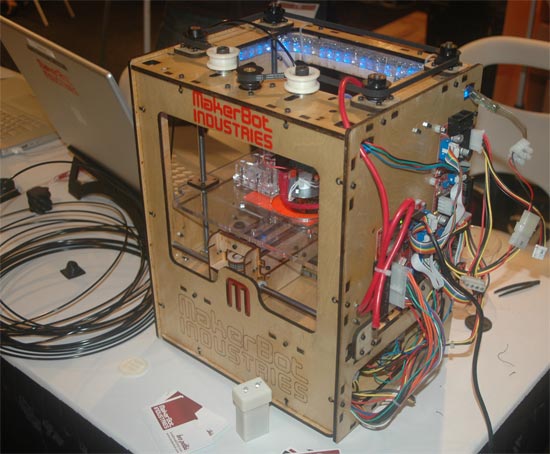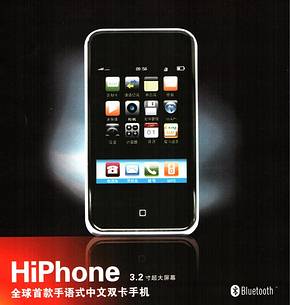Industrial Revolution. Part 3. 3D printer for $ 1000
In the previous parts of the translation of the article "In the Next Industrial Revolution, Atoms Are the New Bits" you could learn about virtual mini-factories and the Rally Fighter - the car created by the "crowd" . Today I will tell you about existing 3D printers and how using www.alibaba.com you can order and produce almost anything in China!
On the territory of the former brewery in Brooklyn, Bra Pettis and his team of engineers assemble MakerBot - the first 3D printer worth less than $ 1,000! Unlike inkjet printers, instead of ink, MakerBot builds objects by extruding a layer of molten plastic (ABS Plastic) 0.33 mm thick. Just 5 years ago, you could not get anything like that for less than $ 125,000.

At the production site, you can see 100 MakerBot boxes lined up and ready to go to your customers. Up to now, 500 MakerBots have already been sold and, with each copy sold, more and more new ideas emerge regarding its possible use. For example, instead of the usual head that squeezes out liquid plastic, you could create a cutting head by making a sawing machine for wood, metal or just ice cubes for drinks from a printer!
')
MakerBot is designed for the manufacture of plastic parts based on a three-dimensional model file. Want to create a gear? Create a gear model and print it on a printer! Want to change the product that you already have? Scan it (researchers at Cambridge University have developed a technology that allows you to create a 3D file by rotating an object in front of a webcam), correct it in a 3D designer, such as Google SketchUp , and upload it to ReplicatorG . Within minutes, you will receive a new physical object.

With the help of other tools, you can do even more! For example, a $ 18,000 ShopBot PRSalpha machine allows you to create wooden products the size of an entrance door. Or you can buy a smaller installation for $ 1,500 from buildyourcnc.com . If you work with metal, try the machine for $ 2000. Well, if you are fond of electronics, create your board with the help of CadSoft Eagle , after which you can make it in Advanced Circuits .
The same applies to laser, plasma and water machines. Using this approach, you can create anything - from jewelry to a car chassis. To be honest, tens of thousands of people do it. We have already seen the do-it-yourself boom on the example of creating T-shirts and mugs, then on the example of Etsy , a portal for the sale of handicrafts (the sales turnover of Etsy last year was about 200 million US dollars ). Now the do-it-yourself boom is turning into more complex applications, such as the creation of 3D models from plastic and open source electronic equipment, such as the innovative Arduino project.
With the help of such tools, individuals can produce products previously available only to full-fledged manufacturers. In addition, over the past few years, Chinese manufacturers have learned how to more effectively handle small orders, which made it possible to produce almost anything at virtually any scale of production.
This situation was caused, firstly, by the maturity and web orientation of the business in China. Chinese factories are accepting more and more orders via the Web, communicating with customers via email, and accepting payments through credit cards or PayPal, a convenient alternative to bank transfers, letters of credit, etc. In addition, the economic crisis has forced companies to look for individual orders that have higher profitability.
To dive into the new world of opportunities that Chinese factories offer, visit Alibaba.com , which is the largest directory of Chinese manufacturers and suppliers. On it, using the usual search, you can find the suppliers you need and then through the instant messaging system (Instant Messaging) to find out if they can do what you need. Alibaba Instant Messaging contains an online translator from English to Chinese, so that people can communicate in their own language. Usually the answer comes in a few minutes: “we cannot do it” or “we can do it and here’s how you can make an order” or “we have already done something similar and that’s how much it will cost”.

The head of Alibaba, Jack Ma, calls this “C to B” (consumer to business, consumer to business). This is a new kind of trade, which is ideal for DIY entrepreneurs. “If we support companies in conducting smaller cross-border operations, profits can be large because, in this case, unique goods will be produced, not“ consumer goods, ”Ma says. Since its founding in 1999, Alibaba has become a company with a turnover of 12 billion US dollars and 45 million registered users worldwide. The company's initial public offering of $ 1.7 billion in 2007 was the largest since Google. According to Ma, over the past three years, companies leading business through Alibaba have created more than 1.1 million jobs in China.
What is happening is very close to shanzhai . The term “shanzhai”, which translates from Chinese as “gangster,” usually refers to a thriving business of fake electronics, or, as shanzhai.com defines, “a supplier who does business without following traditional rules and regulations, which often leads to the emergence of innovative and unusual products or business models. " But what is interesting is that these same suppliers are catalysts for the industrial side of the industrial revolution, quickly and flexibly responding to any wishes of micro-entrepreneurs. Raising the business practice of “shanzhai” “offers a new approach to economic recovery based on a closer connection of small companies with each other,” said Tom Igoy , lead developer of the open source computing platform Audrino. “What happens if you apply this approach in the manufacturing world? We will see soon! ”.

To be continued…
On the territory of the former brewery in Brooklyn, Bra Pettis and his team of engineers assemble MakerBot - the first 3D printer worth less than $ 1,000! Unlike inkjet printers, instead of ink, MakerBot builds objects by extruding a layer of molten plastic (ABS Plastic) 0.33 mm thick. Just 5 years ago, you could not get anything like that for less than $ 125,000.

At the production site, you can see 100 MakerBot boxes lined up and ready to go to your customers. Up to now, 500 MakerBots have already been sold and, with each copy sold, more and more new ideas emerge regarding its possible use. For example, instead of the usual head that squeezes out liquid plastic, you could create a cutting head by making a sawing machine for wood, metal or just ice cubes for drinks from a printer!
')
MakerBot is designed for the manufacture of plastic parts based on a three-dimensional model file. Want to create a gear? Create a gear model and print it on a printer! Want to change the product that you already have? Scan it (researchers at Cambridge University have developed a technology that allows you to create a 3D file by rotating an object in front of a webcam), correct it in a 3D designer, such as Google SketchUp , and upload it to ReplicatorG . Within minutes, you will receive a new physical object.

With the help of other tools, you can do even more! For example, a $ 18,000 ShopBot PRSalpha machine allows you to create wooden products the size of an entrance door. Or you can buy a smaller installation for $ 1,500 from buildyourcnc.com . If you work with metal, try the machine for $ 2000. Well, if you are fond of electronics, create your board with the help of CadSoft Eagle , after which you can make it in Advanced Circuits .
The same applies to laser, plasma and water machines. Using this approach, you can create anything - from jewelry to a car chassis. To be honest, tens of thousands of people do it. We have already seen the do-it-yourself boom on the example of creating T-shirts and mugs, then on the example of Etsy , a portal for the sale of handicrafts (the sales turnover of Etsy last year was about 200 million US dollars ). Now the do-it-yourself boom is turning into more complex applications, such as the creation of 3D models from plastic and open source electronic equipment, such as the innovative Arduino project.
With the help of such tools, individuals can produce products previously available only to full-fledged manufacturers. In addition, over the past few years, Chinese manufacturers have learned how to more effectively handle small orders, which made it possible to produce almost anything at virtually any scale of production.
This situation was caused, firstly, by the maturity and web orientation of the business in China. Chinese factories are accepting more and more orders via the Web, communicating with customers via email, and accepting payments through credit cards or PayPal, a convenient alternative to bank transfers, letters of credit, etc. In addition, the economic crisis has forced companies to look for individual orders that have higher profitability.
To dive into the new world of opportunities that Chinese factories offer, visit Alibaba.com , which is the largest directory of Chinese manufacturers and suppliers. On it, using the usual search, you can find the suppliers you need and then through the instant messaging system (Instant Messaging) to find out if they can do what you need. Alibaba Instant Messaging contains an online translator from English to Chinese, so that people can communicate in their own language. Usually the answer comes in a few minutes: “we cannot do it” or “we can do it and here’s how you can make an order” or “we have already done something similar and that’s how much it will cost”.

The head of Alibaba, Jack Ma, calls this “C to B” (consumer to business, consumer to business). This is a new kind of trade, which is ideal for DIY entrepreneurs. “If we support companies in conducting smaller cross-border operations, profits can be large because, in this case, unique goods will be produced, not“ consumer goods, ”Ma says. Since its founding in 1999, Alibaba has become a company with a turnover of 12 billion US dollars and 45 million registered users worldwide. The company's initial public offering of $ 1.7 billion in 2007 was the largest since Google. According to Ma, over the past three years, companies leading business through Alibaba have created more than 1.1 million jobs in China.
What is happening is very close to shanzhai . The term “shanzhai”, which translates from Chinese as “gangster,” usually refers to a thriving business of fake electronics, or, as shanzhai.com defines, “a supplier who does business without following traditional rules and regulations, which often leads to the emergence of innovative and unusual products or business models. " But what is interesting is that these same suppliers are catalysts for the industrial side of the industrial revolution, quickly and flexibly responding to any wishes of micro-entrepreneurs. Raising the business practice of “shanzhai” “offers a new approach to economic recovery based on a closer connection of small companies with each other,” said Tom Igoy , lead developer of the open source computing platform Audrino. “What happens if you apply this approach in the manufacturing world? We will see soon! ”.

To be continued…
Source: https://habr.com/ru/post/94643/
All Articles